Climate Governance in Australia
Attachments

The CAT Climate Governance series seeks to produce a practical framework for assessing a government’s readiness - both from an institutional and governance point of view - to ratchet up climate policy and implement adequate transformational policies on the ground, to enable the required economy-wide transformation towards a zero emissions society.
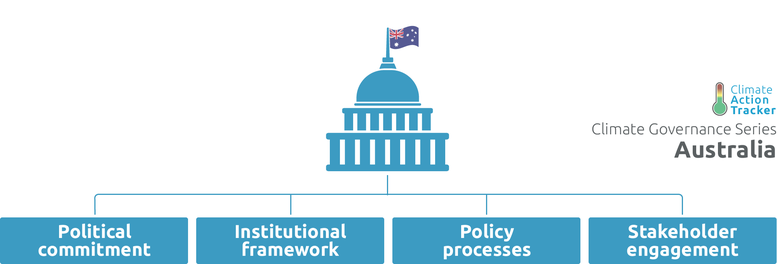
Our methodology
We have set up a framework that assesses and scores a number of indicators, where we rate various aspects of governance. This allows us to establish a common basis on which to compare climate governance across countries as well as identify areas of improvement and highlight positive developments. We have applied this framework at both a national level and on key emissions-intensive sectors of the economy. In Australia's case we have focused on the industry sector.
For the purpose and overview of this series, see our Climate Governance series main page. The methodology framework used for this Australia assessment is here. For more detail on our methodology, see here: methodology page.
Assessment of national level readiness
Australia is lacking the national political commitment to stimulate the economy-wide transformational changes required for increased climate mitigation ambition. High level government climate leadership is not only absent, but the government is even directly undermining adequate climate mitigation. The quality of government decision making has been hampered by frequent changes in government, and the institutional and policy landscape. These events impede the likelihood of ambitious climate policies and the operations of government entities such as the Climate Change Authority.
Australia’s institutional framework lacks the effective coordination across ministries, agencies and sub-national governments that is necessary for efficient and consistent climate policy. Independent research institutes provide a wealth of knowledge that could inform policy-making decisions. Despite Australia’s high vulnerability to climate change, the government has a history of ignoring the climate research efforts and advice of its independent government agencies such as the Climate Change Authority, universities, non-government research organisations, as well as IPCC assessments. Human resource constraints remain barriers to effective climate governance, as there are few climate-related roles, high rates of staff turnover, and relatively low budget levels, all reflecting a government in clear denial of its climate change commitments.
Australia needs to improve its transparency framework by ensuring the timeliness and transparency of its reporting, including in relation to land based activities, clearly quantifying the projected and actual effect of its mitigation policies, and producing regular reports of how the country is tracking towards the Paris Agreement goals at sectoral, State and National levels. Increased and secured funding for the Climate Change Authority would strengthen its ability to provide independent assessment, review and tracking of mitigation policy. Furthermore, Australia needs establish a ratchet up mechanism to strengthen its current Nationally Determined Contribution (NDC) to become consistent with the Paris Agreement long-term, 1.5˚C temperature goal. To date, the government has ignored the requirement under the Paris Agreement enabling decisions to submit by 2020 a revised and more ambitious NDC for 2030 and did not meet the call by the UN Secretary General and the Pacific Island Forum members to that effect. The government needs also develop a long-term Paris-compatible decarbonisation strategy, which is also to be submitted by 2020.
While there is stakeholder engagement through public consultations on specific aspects of policy, there is a strong focus on the interests of industry - in particular fossil fuel and mining industry groups - when drawing conclusions from these consultations, while ignoring the interests of other stakeholders such as youth, farmers, or the health sector. The government continues to support fossil fuel industries, through initiatives such as the Gas Acceleration Programme and possible new coal-fired power generation, as well as new coal mining, which are all inconsistent with the Paris Agreement and the need for rapid decarbonisation.
Rating system
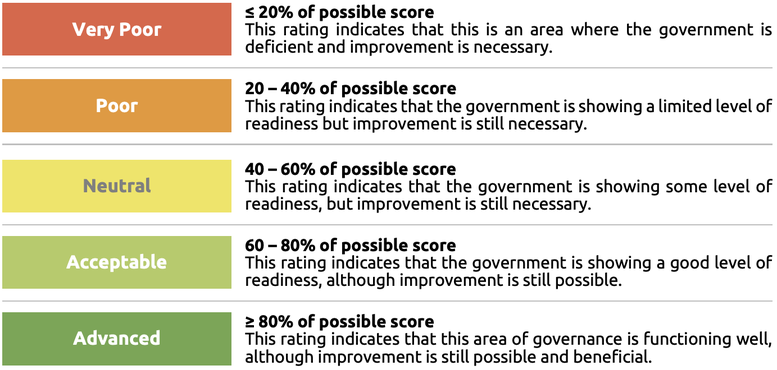
We analyse ten different criteria of governance under four categories that cover the key enabling factors for effective climate action. We give each a rating as outlined above (poor - neutral - advanced). The methodology framework used for this Australia assessment is here. For more detail on our methodology in general, click the link below.
Ratings and Recommendations
The following section outlines the results of the analysis for each of the different categories and criteria as well as our recommendations for each category of governance.

- Live up to the Paris Agreement and establish an adequate climate mitigation policy. Uphold the policy with political commitment to, and prioritisation of, climate change mitigation.
- High level officials should actively engage and support climate related international initiatives.
- Create a dedicated institution or team responsible for climate-mitigation related activities to support climate policy with the ability to exercise a strong influence on government decision-making.
- Ensure climate change mitigation as a political priority for the Minister for Energy and Emissions Reduction.
- Commit to a long-term climate policy strategy and legislation, as well as specific short- and medium-term mitigation actions, through policies and projects, spurring government and private investment in climate finance, technology, and capacity building

- Establish coordination of policy actions between and within government departments, though taking on board suggestions made by the Council of Australian Governments (COAG), such as to include climate change on the energy policy agenda.
- Re-instate the role of the Climate Change Authority and non-governmental independent research institutes in policy development and review, and provide the Climate Change Authority and the Clean Energy Regulator with adequate resources to continue their roles.
- Establish a climate mitigation team or institution within the Department of Environment and Energy with adequate resources and capabilities for designing and implementing ambitious climate policy and effective climate mitigation outcomes.

- Submit by 2020 a revised and more ambitious NDC for 2030 and establish a national zero emission GHG reduction goal for 2050 in line with the Paris Agreement.
- Prepare a long term low GHG development strategy that couples near-term policy development and implementation with decadal milestones and emission reduction targets that lead to zero emissions in 2050.
- Clearly and transparently quantifying the projected and actual effect of its mitigation policies with government emissions projections, detailed and transparent sector-specific models and analysis with annual reports to assess how the country is tracking towards the Paris Agreement goals at sectoral, State and National levels. Within this framework, supplement the current National Greenhouse and Energy Reporting (NGER) system to cover all sectors.
- Adhere to the deadlines set by the Senate for the timely release of quarterly GHG emissions updates.
- Increase the transparency of its reporting through, inter alia, quantifying the effect of its mitigation policies.
- Provide stable, secure and enhanced funding to the Climate Change Authority.
- Develop a ratchet-up mechanism to review and improve the current and future NDCs based on independent scientific advice (such as the Climate Change Authority), linked to national climate legislation and the international review process under the Paris Agreement that started in 2018 with the Talanoa Dialogue informed by the IPCC Special report on 1.5oC.

- Create or support independent research entities to disseminate information related to climate impacts, climate mitigation and the importance of climate change to the public, such as the now defunct Climate Commission.
- Engage stakeholders broadly in the development of mitigation strategies and policies across sectors, ensuring buy-in from stakeholders, including those at risk from climate change - and those that profit from climate policy - into policy making.
- Develop a national policy to address the issues of – and compensate those negatively affected by - the transition to renewable energy and decarbonisation (in particular in the fossil fuel mining and extraction sectors).
Australia's Climate Governance
These tables from the report give an overview and analysis of the key factors of Australia's governance to enable effective climate action. We look at the country's key institutions, strategies, targets and legislation, as well at a sectoral level for the industry sector.
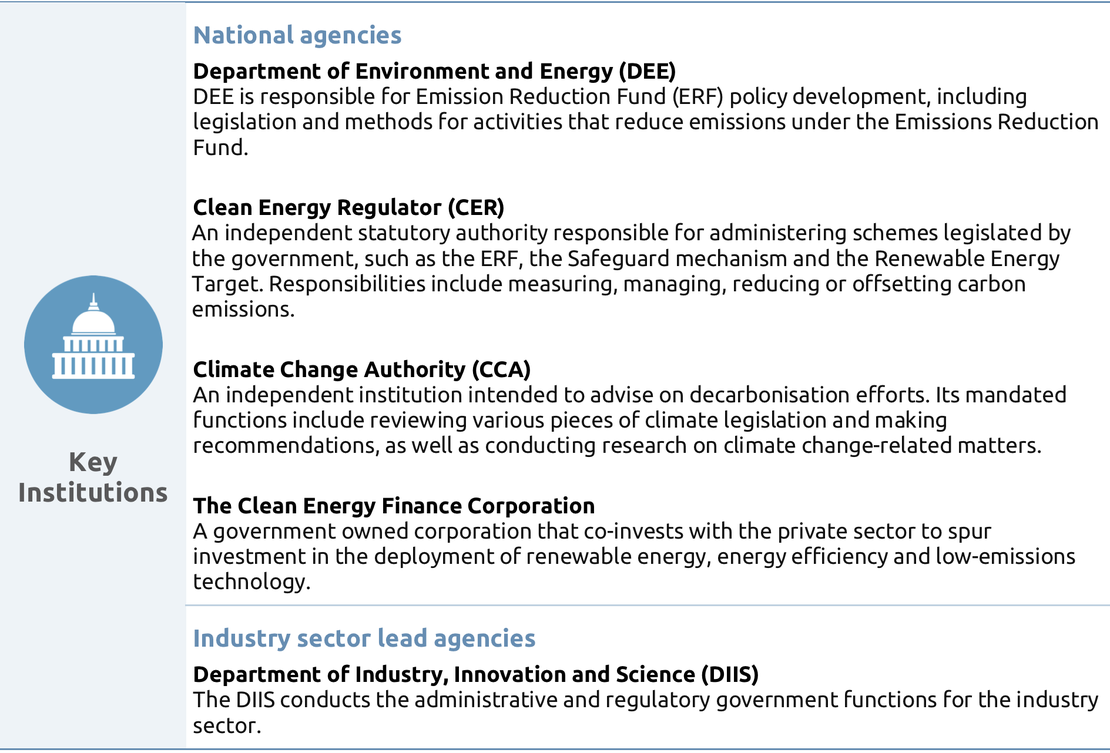

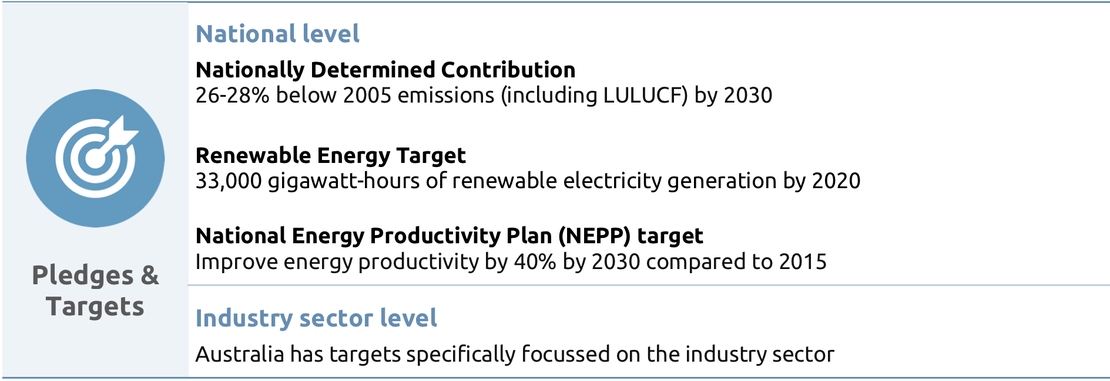
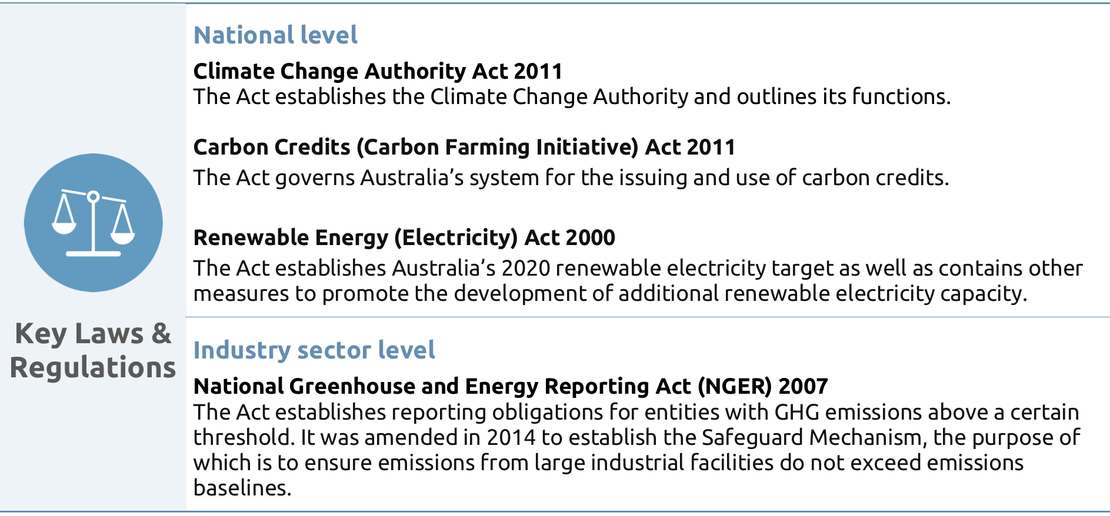
Assessment of sectoral level readiness
The report also assesses the readiness of Australia's industry. See the report for details.
Other reports
Stay informed
Subscribe to our newsletter